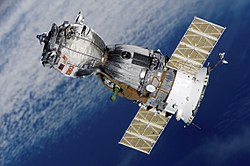 The Soyuz T-10 return capsule on display at the Nehru Planetarium in New Delhi, India | |
| Mission type | Dock with Salyut 7 |
|---|---|
| Operator | Experimental Design Bureau (OKB-1) |
| COSPAR ID | 1984-014A |
| SATCAT no. | 14701 |
| Mission duration | 62 days 22 hours 41 minutes 22 seconds |
| Spacecraft properties | |
| Spacecraft | Soyuz 7K-ST No.15L |
| Spacecraft type | Soyuz-T |
| Manufacturer | Experimental Design Bureau (OKB-1) |
| Launch mass | 6850 kg |
| Landing mass | 2800 kg |
| Crew | |
| Crew size | 3 |
| Launching | Leonid Kizim Vladimir Solovyov Oleg Atkov |
| Landing | Yuri Malyshev Gennadi Strekalov Rakesh Sharma |
| Callsign | Mayak (Beacon) |
| Start of mission | |
| Launch date | 8 February 1984, 12:07:26 UTC |
| Rocket | Soyuz-U s/n Yu15000-357 |
| Launch site | Baikonur, Site 31/6 |
| Contractor | Experimental Design Bureau (OKB-1) |
| End of mission | |
| Landing date | 11 April 1984, 10:48:48 UTC |
| Landing site | 160 km at the east of Dzhezkazgan, Kazakhstan |
| Orbital parameters | |
| Reference system | Geocentric orbit |
| Regime | Low Earth orbit |
| Perigee altitude | 199.0 km |
| Apogee altitude | 219.0 km |
| Inclination | 51.6° |
| Period | 88.7 minutes |
| Docking with Salyut 7 | |
| Docking date | 13 April 1984 |
Soyuz T-10 was the fifth expedition to the Salyut 7 space station. It entered a darkened and empty station because of the loss of Soyuz T-10a. It was visited by the sixth and seventh expeditions. During the course of the cosmonauts stay, three extravehicular activities took place to repair a fuel line. [1]
Contents
- Crew
- Backup crew
- Mission parameters
- Mission highlights
- Spacecraft location
- References
- External links
During their multiple spacewalks to perform maintenance on the station, the crew set a record for spacewalk hours. [2]
